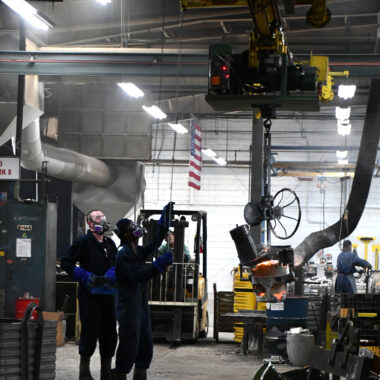From Design to Finish: The Total Light Weight Aluminum Casting Refine Demystified
In the world of manufacturing, the procedure of light weight aluminum casting stands as a pivotal method that has fueled sectors for decades. Keep tuned as we dissect the complete aluminum spreading procedure, uncovering the intricacies that change raw materials into refined items.
Creating the Casting Mold And Mildew
When launching the aluminum casting procedure, meticulous interest to creating the casting mold and mildew is extremely important for guaranteeing the end product's integrity and high quality. The spreading mold functions as the structure for the whole casting process, determining the shape, dimensions, and surface area coating of the ultimate aluminum component.
To make a reliable spreading mold, designers must take into consideration numerous aspects such as the complexity of the component, the sort of light weight aluminum alloy being utilized, and the wanted residential or commercial properties of the end product. about aluminum casting. Computer-aided design (CAD) software is frequently utilized to develop thorough schematics of the mold, enabling for specific modification and optimization
In addition, the style of the spreading mold and mildew directly impacts the efficiency and cost-effectiveness of the spreading process. A well-designed mold lessens product waste, reduces the demand for comprehensive post-casting machining, and improves overall manufacturing rate.
Melting and Putting Aluminum
With the layout of the casting mold and mildew wrapped up, the following crucial step in the light weight aluminum spreading procedure is the melting and putting of the light weight aluminum alloy. As soon as the aluminum is molten, it is crucial to preserve the temperature within a specific range to ensure the quality of the spreadings.
The molten light weight aluminum is carefully transferred from the furnace to the spreading mold. Correct pouring methods contribute substantially to the total top quality of the final light weight aluminum casting.
Solidifying and Cooling Down Refine
Upon completion of the putting process, the liquified aluminum shifts into the strengthening and cooling stage, an essential stage in the aluminum casting procedure that straight impacts the last product's honesty and attributes. As the aluminum begins to cool, its particles arrange themselves right into a strong type, gradually taking on the form of the mold.
Throughout this phase, it is important to regulate the cooling process meticulously to stay clear of defects such as porosity, shrinking, or interior tensions. Different cooling methods, such as air cooling, water quenching, or regulated air conditioning chambers, can be used based upon the particular demands of the casting (about aluminum casting). By checking and regulating the solidification and cooling procedure, suppliers can guarantee the production of premium aluminum spreadings with the wanted metallurgical and mechanical homes

Getting Rid Of the Final Casting
When the light weight aluminum casting has adequately strengthened and cooled down in the mold, the following action in the procedure involves thoroughly eliminating the final spreading. This step is important to make certain that the light weight aluminum part is successfully removed with no damage or problems.
To eliminate the spreading, the mold is opened, and the casting is drawn out using various approaches depending upon the intricacy of the part and the mold style. For simpler forms, the casting can usually be quickly eliminated by hand or with straightforward devices. Nonetheless, for even more detailed layouts, added equipment such as ejector pins, air blasts, or hydraulic systems may be required to facilitate the elimination procedure without creating any kind of injury to the spreading.
After the casting is efficiently gotten rid of from the mold and mildew, any type of excess material such as gates, runners, or risers that were made use of throughout the casting process are cut off. This action assists in achieving the last wanted shape of the aluminum component prior to it goes through any added completing procedures.
Finishing and Top Quality Assessment
The final phase in the light weight aluminum casting procedure entails careful completing strategies and extensive quality Visit Website inspection methods to make sure the integrity and accuracy of the cast light weight aluminum parts. look at more info Completing methods such as grinding, fining sand, and shot blasting are utilized to remove any type of excess material, smooth rough surfaces, and improve the aesthetic appeal of the end product. These procedures not only boost the appearance yet likewise ensure that the components meet the defined dimensional tolerances and surface area coating needs.

Final Thought
In final thought, the aluminum spreading procedure includes designing the mold and mildew, melting and putting light weight aluminum, solidifying and cooling the spreading, getting rid of the final product, and do with a high quality inspection. Each action is critical in making certain the final product satisfies the desired requirements. By recognizing the whole process, suppliers can produce premium aluminum spreadings successfully and effectively.
Stay tuned as we study the total aluminum spreading process, uncovering the details that transform raw products right into polished items.
With the design of the spreading mold and mildew settled, the following crucial action in the aluminum casting procedure is the melting and pouring of the aluminum alloy.Upon completion of the putting process, the molten light weight aluminum transitions into the cooling down and strengthening phase, a critical stage in the light weight aluminum casting process that directly influences the last product's honesty and qualities.The final phase in the light weight aluminum casting process includes careful completing strategies and rigorous high quality assessment protocols to guarantee the integrity and precision of the cast aluminum components.In verdict, the aluminum casting procedure includes creating the mold and mildew, melting and putting light weight aluminum, strengthening and cooling the casting, eliminating the last item, and ending up with a quality inspection.